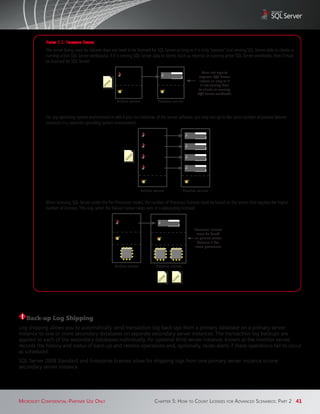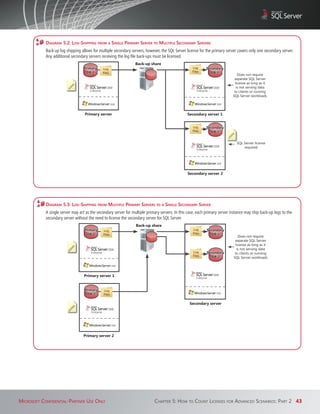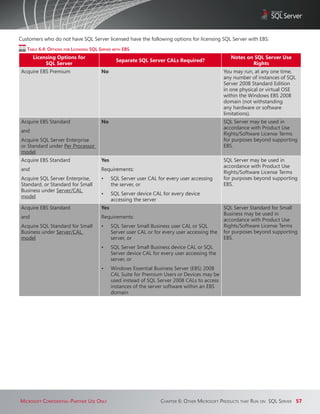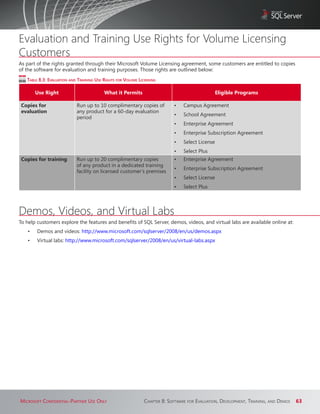This document provides an overview of the different sales channels and volume licensing programs for Microsoft SQL Server. It discusses the various SQL Server versions and editions, restrictions on their deployment, and supported languages. It also outlines the major volume licensing programs for end customers and partners, including details on SKU types, program types, and applicable legal terms for each channel.
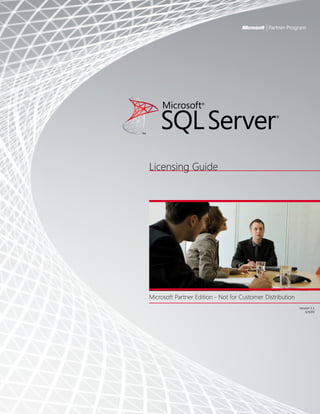


![Chapter 1: What is Sold: SQL Server Releases
In thIs Chapter
SQL Server Versions and Editions 1
Multi-Language Support 3
Restrictions on Deployment 4
Key Terms InTroduced
Edition: The “level“ of the product (e.g.”Enterprise” or “Standard”)
Platform: The operating system environment on which applications run (e.g. x86 [32-bit] or x64 [64-bit])
Version: The release of the product (e.g. SQL Server 2005 or SQL Server 2008)
SQL Server Versions and Editions
The table below provides a summary of the versions and editions for Microsoft® SQL Server® 2008, SQL Server 2005, and
SQL Server 2000.
Note: The information and examples used in this guide generally apply to SQL Server 2008. Licensing rules for prior versions
are the same except where noted.
Table 1.1: SQl Server verSionS and ediTionS
Platforms Supported
Editions IA64 Target Scenarios for SQL Server 2008 Editions
x86 x64
(64-bit
(32-bit) (64-bit)
Itanium)
• Enterprise workloads that need redundancy
SQL Server 2008 Enterprise • • •
and built-in Business Intelligence
SQL Server 2005 Enterprise • • • • Enterprise virtualization
• Server farm with license mobility
SQL Server 20001 Enterprise • • •
SQL Server 2008 Standard • • • Shared data scenarios in departments
and small to large businesses
SQL Server 2005 Standard • • • • Departmental
SQL Server 2000 Standard • • Essential Business Server customers
SQL Server 2008 Developer • • • • Full featured edition for
development and testing only
SQL Server 2005 Developer • • •
SQL Server 2000 Developer •
SQL Server 2008 Workgroup • • • Remote/branch offices that need
local instances of company data
SQL Server 2005 Workgroup • •
• Small scale
Microsoft confidential‑Partner Use only chaPter 1: What is sold: sQl server releases 1](https://image.slidesharecdn.com/sqlserverlicensingguidepartnerednv1-1-100420160316-phpapp02/85/Sql-server-licensing_guide_partneredn_v1-1-4-320.jpg)





















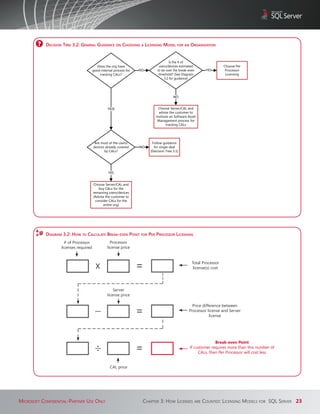







![diagram 4.5: counTing licenSeS for vmS (Per ProceSSor model)
With data points A – C below, you have the information you need to calculate the number of Processor licenses required for most virtualization
scenarios:
Virtual
machine
(VM)
A. # of virtual processors
supporting the VM
B. # of cores per physical
processor (if hyper-threading Physical
off) or # of threads per physical HTT
server
processor (if hyper-threading
in on)
C. # of physical processors
Hyper-threading
setting (on or off)
Below you will find instructions on how to use the data points and formulas to calculate the required Processor licenses for:
1. SQL Server running on a single virtual machine (VM)
2. SQL Server running on multiple VMs
3. SQL Server running on one or more VMs and the physical OS environment (POSE)
How to Calculate Processor Licenses for a Single VM
For a single VM, you divide data point A (number of virtual processors supporting the VM) by data point B (# of cores [HTT
off] or threads [HTT on] per physical processor) to calculate the number of Processor licenses required for any SQL Server
edition(s) that will be licensed. If the result is not a whole number, then you round up to the next whole number.
diagram 4.6: formula for calculaTing ProceSSor licenSeS reQuired for a Single vm
Round fractions up
to the next whole
number
A B
.
. = # of Processor
licenses required
# of virtual # of cores (hyper-
processors threading off) or
supporting threads (if hyper-
the VM threading on) per
physical processor
Microsoft confidential‑Partner Use only chaPter 4: hoW to coUnt licenses for advanced scenarios: Part 1 31](https://image.slidesharecdn.com/sqlserverlicensingguidepartnerednv1-1-100420160316-phpapp02/85/Sql-server-licensing_guide_partneredn_v1-1-34-320.jpg)









